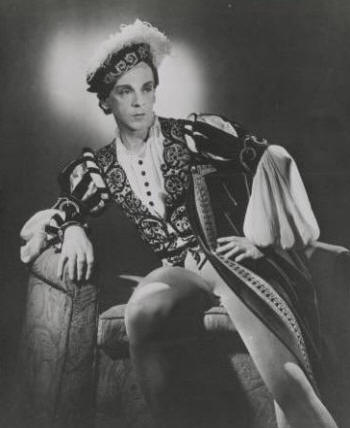Sir Robert Helpmann
dancer, choreographer, actor, director
9th April
1909 - 28th September 1986
In the world of athletics, the general public tends to remember who was
best in the world at sprinting or high jump or javelin and forget the rest.
Those with a deeper appreciation are more likely to recognise competitors in
the pentathlon � those who are world class across a range of different
disciplines � as the really great athletes. In his chosen field of the arts,
Robert Helpmann proved himself to be world class not just as a ballet
dancer, but also as a stage actor, screen actor, choreographer , director
and festival organiser, and those with a deeper appreciation of the creative
process recognise this as the hallmark of a truly great artist.
Few people
can claim to have danced the role of Hamlet for one of the world�s
major ballet companies and within a couple of years to have acted the role
Shakespeare�s Hamlet on stage. Even fewer could match the breadth of
talent that Helpmann displayed at the
Sydney Opera House
in 1981 where in one theatre he gave a critically acclaimed acting
performance in Fleming's The Cobra, in another he directed the
Australian Opera production of Gounod's Romeo et Juliette while in a third theatre space his
re-choreographed version of The Display was danced. All of this was
to celebrate 60 years in the theatre for an artist who was showing no signs
of slowing down.
Robert Helpman (he later added the extra �n� for his stage name) was born in
the rural South Australian centre of
Mount Gambier. In early
20th century Australia this was the place where you might mix with the sons
and daughters of the wealthier graziers in the region who had been sent
there to boarding school; and you might have the opportunity to become
involved in amateur theatre, but it was not really the place to be exposed
to the world of classical ballet. However young Bobby showed talent and
determination in the area of dance and attended ballet classes in Adelaide,
even though the teacher had never had experience in teaching boys. His
father whilst on a business trip to Melbourne managed to persuade the
visiting ballerina Anna Pavlova to take him on and Bobby�s professional
career was under way.

His dancing career was to lead him to London where he
was a principal dancer for Covent Garden from 1933 through to 1950. Compared
to the European boys who had usually commenced their concentrated training
at an early age, Helpmann�s later maturing dancing skills were still
developing as his body was passing its dancing prime. This still proved no
impediment to him creating numbers of memorable roles and being declared by
Margot Fonteyn as her favourite partner.
Helpmann expanded his artistic career by acting on stage and film. The
Red Shoes became one of the most successful films of its era and
Helpmann starred in it as both actor/dancer and choreographer. Later film
roles were to include the role of the Child Catcher in Chitty Chitty Bang
Bang.
|
|
The Red Shoes
In this famous 1948 film based on the Hans Christian Andersen
fairy tale, Helpmann appears as an actor/dancer. He also
choreographed the lengthy opening scene.
Other performers include Anton Walbrook, Marius Goring, Moira
Shearer and L�onide Massine.
|
|
|
Chitty Chitty Bang Bang
In this children's film, Helpmann has a brief but unforgettable
role as the Child Catcher.
Helpmann excelled in melodramatic roles, and this one has created
many a nightmare for children over the years.
|
|
|
Cinderella
In this splendid Royal Ballet production of Cinderella the
music is by Prokofiev
and the choreography by Frederick Ashton.
Ashton and Helpmann play the ugly sisters as a pair of panto
dames and provide an ideal foil to the romantic story line.
|
|
|
Don Quixote
This filmic version of the Australian Ballet's production of
Don Quixote features Rudolf Nureyev, Lucett Aldous and Robert
Helpmann at their best.
The DVD also features a discussion with Nureyev and Helpmann
about how the production was brought to this film version.
The music is by Minkus with additions by John Lanchbery.
|
|
|
Miracle In The Gorbals
The ballet Miracle in the Gorbals with music by Arthur
Bliss.
|
| |
|